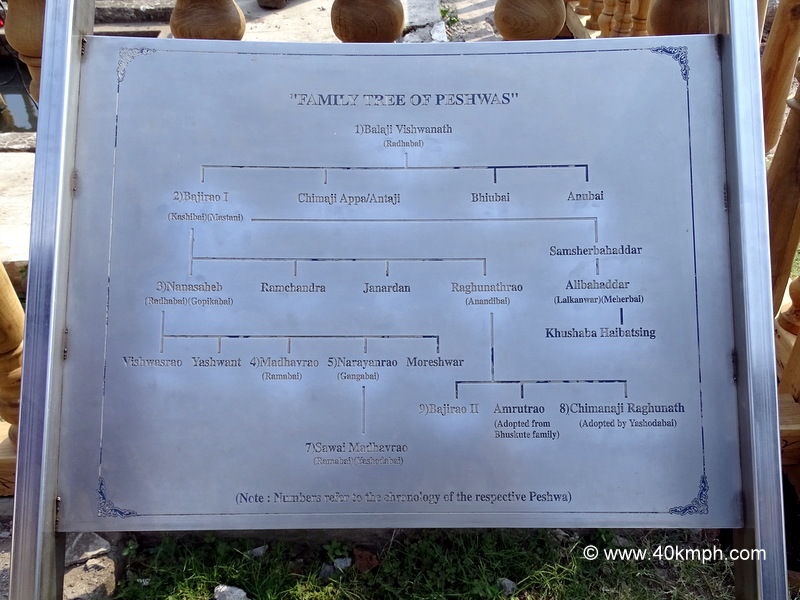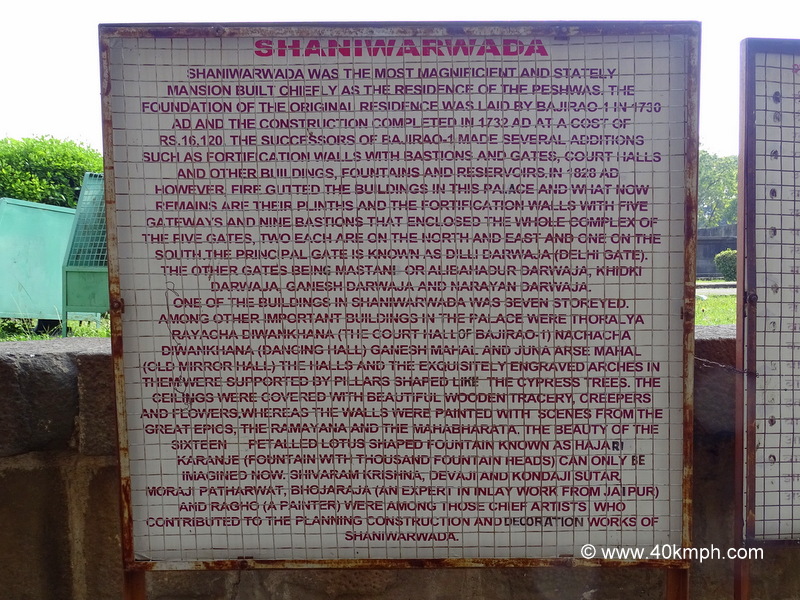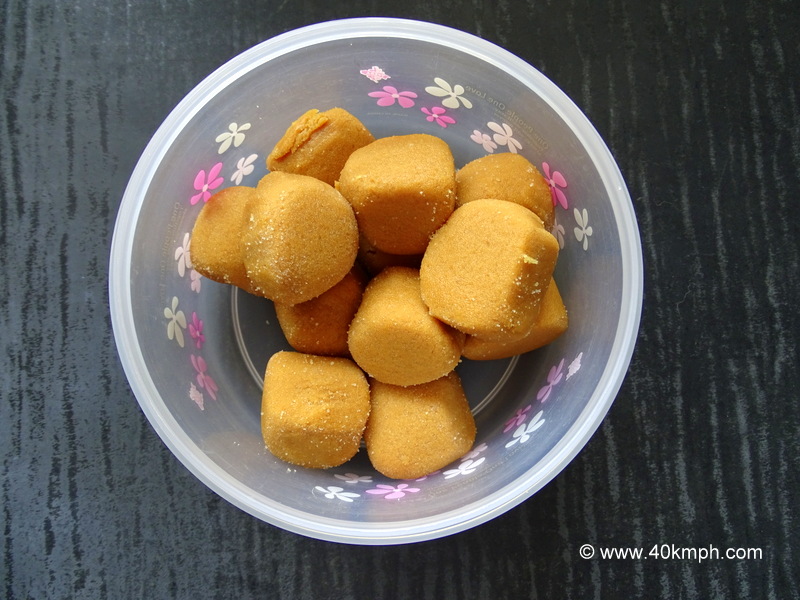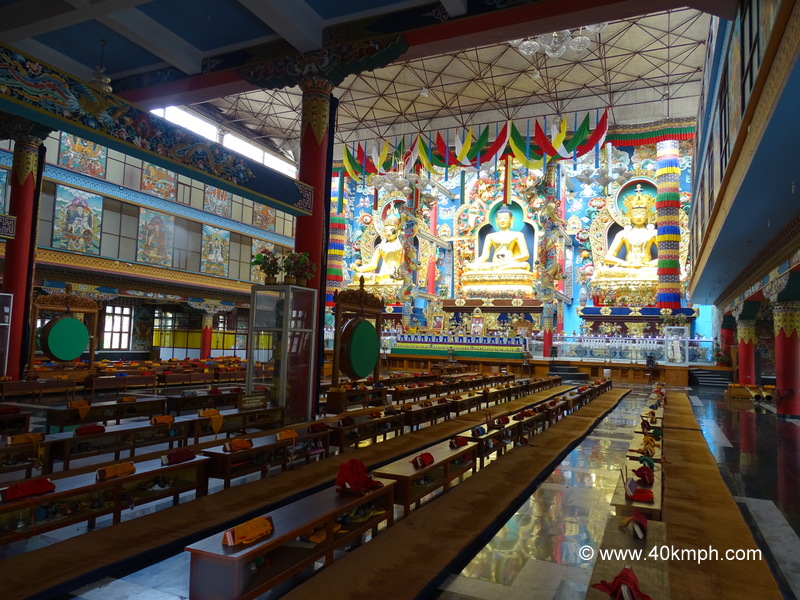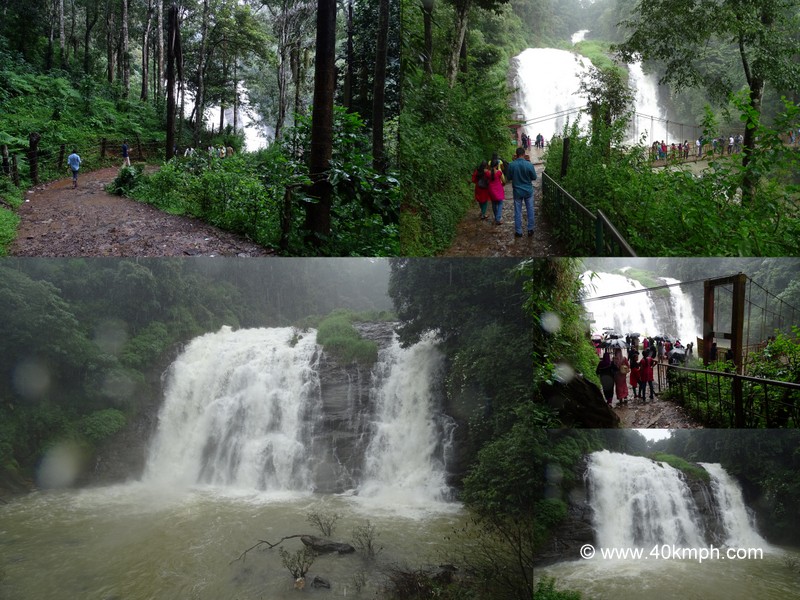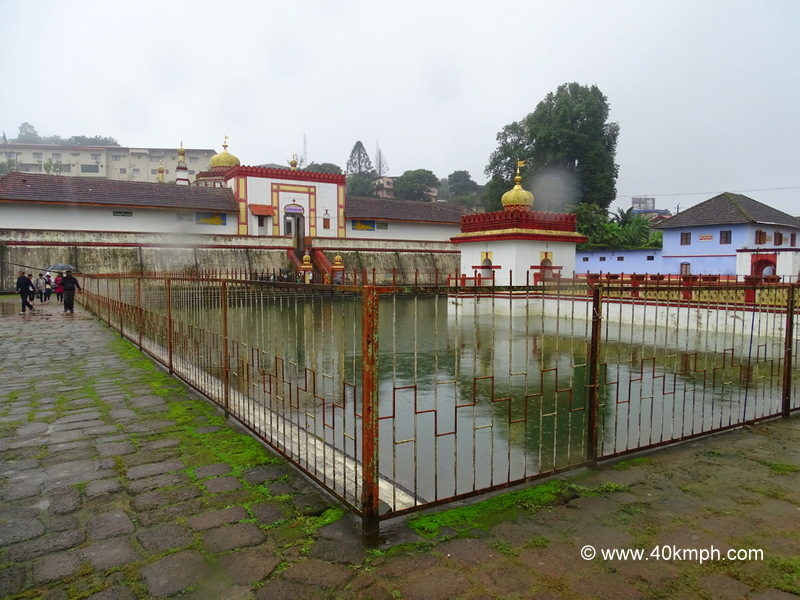Click to learn more about ‘Peshwas’.
History of Shaniwar Wada Fort – Built in 1732 AD
शनिवार वाड़ा
शनिवारवाड़ा सबसे भव्य और आलीशान हवेली थी जिसे मुख्य रूप से पेशवाओं के निवास के रूप में बनाया गया था। मूल निवास की नींव बाजीराव प्रथम ने 1730 ई. में रखी थी और निर्माण 1732 ई. में 16,120 रुपये की लागत से पूरा हुआ था। बाजीराव-1 के उत्तराधिकारियों ने किले की दीवारों में गढ़ और द्वार, कोर्ट हॉल और अन्य इमारतें, फव्वारे और जलाशय जैसे कई अतिरिक्त निर्माण किए। हालाँकि, 1828 ई. में आग ने महल की इमारतों को नष्ट कर दिया और अब जो कुछ बचा है वह उनके चबूतरे और किले की दीवारें हैं जिनमें पाँच प्रवेश द्वार और नौ बुर्ज हैं जो पूरे परिसर को घेरे हुए हैं या पाँच द्वार हैं, उत्तर और पूर्व में दो-दो और दक्षिण में एक । मुख्य द्वार को दिल्ली दरवाजा (दिल्ली गेट) के नाम से जाना जाता है। अन्य द्वार मस्तानी या अलीबहादुर दरवाजा, खिड़की दरवाजा, गणेश दरवाजा और नारायण दरवाजा हैं।
शनिवारवाड़ा की एक इमारत सात मंजिला थी। महल की अन्य महत्वपूर्ण इमारतों में बाजीराव -1 का दरबार हॉल, नृत्य हॉल, गणेश महल और पुराना दर्पण हॉल थे। हॉल और थीम में उत्कृष्ट रूप से उत्कीर्ण मेहराबों को सरू के पेड़ों के आकार के स्तंभों द्वारा समर्थित किया गया था। छतें सुंदर लकड़ी की सजावट, लताओं और फूलों से ढकी हुई थीं, जबकि दीवारों को महान महाकाव्यों, रामायण और महाभारत के दृश्यों से चित्रित किया गया था। सोलह पंखुड़ियों वाले कमल के आकार के फव्वारे की सुंदरता जिसे हजार फव्वारे सिर वाला फव्वारा के नाम से जाना जाता है, की अब केवल कल्पना ही की जा सकती है। शिवराम कृष्ण, देवजी और कोंडाजी सुतार, मोरज पथरवत, भोजराजा (जयपुर से जड़ाउ कार्य में एक विशेषज्ञ), और राघो (एक चित्रकार) उन प्रमुख कलाकारों में से थे जिन्होंने शनिवारवाड़ा के निर्माण और सजावट कार्यों की योजना बनाने में योगदान दिया।
(English to Hindi Translation by Google Translate)
Who invented (since 1846) Dharwad Peda?
Click to learn more about the inventor of Dharwad Peda.
A Day Trip to Kaas Plateau from Mumbai (to and fro)
We hired a car driver for a day costing Rs. 1,000 plus food. We started our journey from Mumbai at 4:45 am. After 45 km of driving at 5:35 am, we reached Mumbai-Pune Expressway. After crossing Khalapur toll tax we stop at Hotel Neeta International for breakfast. We had 3 idlis, 3 vadas plus 3 tea. Cost Rs. 285 paid. We restarted our journey after breakfast. After another 62 km of driving, the Mumbai-Pune expressway ends. The time was 7:20 am. At 8:50 am we again stopped for a cup of tea at Pargaon. Tea Rs. 15 and Bhajiya Rs. 15. We paid Rs. 60 for three people. After another 46 km and a total of 267 km by now we reached the right turn for Satara City. We took a right turn that goes to Kaas via Satara City. After 21 km more driving we reached Kaas Plateau at 11:20 am.
Kaas Plateau from Mumbai Distance is 295 Km approx.
Total journey hours to Kaas Plateau from Mumbai is 6 hours 30 minutes approx.
The entry fee per person at Kaas Plateau is Rs. 10/-.
Four-wheel parking cost – Rs. 40,
Digital Camera charges Rs. 100/-.
Total Rs. 180 we paid.
We spend about 2 hours at Kaas Plateau with guide Shyam Rao Kadam. He charged us Rs. 100 per hour. He showed us many varieties of flowers such as Balsam, Abolima, Nilima, Topli Karvi, Brochera, Brahmini, Raan Halak, Toothbrush Orchid, Deep Kandi, Iltukoloria, Chandni Gend, Karnphool, Big Sunki, Kandil Pushp, Hathi Sund, Karwand, Jambul, Dupli Karvi, Dagdi Phool, Mickey Mouse, Tutari, Chendu Gend, Jambli Manziri and many more…
After spending about 2 hours at Kaas plateau, we were hungry. While returning, we stop at Hotel Blue Valley nearby Kaas plateau for lunch. Two of us had non-veg. thali (Rs. 180) and one veg. thali (Rs. 140). The quality of lunch was too good.
After another 295 km of driving we reached Mumbai at 9:15 pm.
Total toll tax we paid to and fro approx. Rs. 665.
Though flowers at Kaas Plateau can be seen from August till October but the best time to visit Kaas Plateau as per the guide is September and October.
Kaas Plateau is in 550 hectares land. In the year 2012, it is declared a World Heritage site by UNESCO. There are about 130 varieties of flowers. The altitude is 1213 meters.
A must-visit plateau at least once.
Golden Temple in Kodagu – Distance from Madikeri Town
9:00 am we started our journey by hiring a cab from Madikeri town for the Golden Temple. On the way, we first visited Omkareshwar Temple in Madikeri town.
At 10:20 am we re-started our journey to the Golden Temple. At 11:20 am we reached Golden temple situated at Kodagu.
Golden Temple in Kodagu – Distance from Madikeri Town – We covered approx. 52 km.
Rs. 20 we paid for parking.
Vintage Cars near Madikeri Town – Worth a Visit
After lunch at 3:45 pm, we started our journey from Madikeri town via a hired cab. It is a 31 km drive. At 4:40 pm we reached vintage cars.
There is an entrance fee as below:
Adults – Rs. 100
Children 5 years – Free
5 to 15 – Rs. 50
Foreign Nationals – Rs. 300
Camera Fees
Mobile – Rs. 30
Professional Camera – Rs. 100
Video Camera – Rs. 300
As I walk inside the showroom I saw Morris 9 – 1936, Morris 8 – 1936, Ford Model Y – 1936, Morris 8 – 1946, Ford Anglia – 1949, Morris Minor – 1951, Triumph Mayflower – 1951, Ford Mercury – 1951, Ford Popular – 1953, Vanguard – 1957, Morris 8 series E, Volkswagen Beetle – 1976 and many more models on display including motorbikes.
Luckily, I met the owner but was unable to know more (except there are total of 85 cars) about vintage cars as he speaks only local language, but still, vintage cars are worth a visit. Though the showroom is only one year old, but various cars and bikes are 36 years collection. One should visit.
Talakaveri – The Origin Place of Holy River Kaveri
11:20 am we started our journey via cab from Madikeri Town for Talakaveri (birthplace of Cauvery river) following Mangalore Ghat road. After 8 km of driving a left turn that goes straight to Talakaveri. 33 km driving and we reach Bhagamandala. Rs. 25/- toll tax paid. 12:40 noon hours after driving 8 more km we reach Talakaveri.
The total distance from Madikeri Town to Talakaveri is approx. 49 km
The total journey hours from Madikeri Town to Talakaveri is approx. 1 hour 20 minutes.
We met Narayan Acharya – The head priest. Upon the request he narrated The History as follows:
There are seven important holy rivers in India – Ganga, Yamuna, Godavari, Saraswati, Narmada, Sindhu, and Kaveri. Talakaveri is the birthplace of the Kaveri River. From here Kaveri the river starts as a river flowing via Karnataka, Kerala, and Tamil Nadu finally merging into the Bay of Bengal near Poompuhar Town in Tamil Nadu. Kaveri is Agasthya rishi wife. Agasthya rishi meditate here above Brahmagiri Mountain. 360 steps are there to reach the top of Brahmagiri Mountain. It is a good viewpoint. If the weather is clear and there is no fog you can watch part of Kerela state and the 60 km seashore.
Thank you – said I and we offer prayers.
More from a display board:
The Ashwatha tree here believe to be the shoot of the original tree under which Agasthya muni meditated.
At the level above are temples of Agastheshwara and Ganpati. Local legends have it that Sage Agasthya had originally installed a linga of sand and offer worship here.The birth of Agni
Ashwatha peepal is found in most temple premises. It’s sacred perhaps comes from Vedic rituals of tingling the sacrificial fire by friction between two pieces of wood. One of which was Ashwatha ceremony called the birth of Agni. Different part of the trees have different medicinal properties.
Abbey Waterfalls – Also known as Jessey Waterfall
History of Abbey Waterfalls
The Madikeri stream also called Muttramuttu, falls 21.3 meter between huge boulders to a deep rocky valley to form this picturesque Waterfall called Abbi falls (abbi means waterfalls in Kodavatak). The British called it the Jessey waterfall in memory of Jessey, the daughter of Madikeri’s first chaplain. Every year a few unwary people meet an unfortunate end over the slippery rocks here.
(Source: Display Board)
Abbey Waterfalls distance is 8 km from Madikeri Town.
We reached there at 1:10 pm.
Parking charges for the car is 40 rupees.
A Brief History of Sri Omkareshwara Temple in Madikeri
History of Sri Omkareshwara Temple
A legend is associated with this temple, built by Lingarajendra II in A.D. 1820. The king put to death a pious Brahmin who dared to protest against his misdeeds. The spirit of the dead man began to plague the king day and night. On the advice of wise men, the king built this temple and installed in it a Shivalinga procured from Kashi, and thus freed himself from the curse.
The Omkareshwara temple tank houses the common carp (Catla catla) introduced to keep the water free of organice matter and pollution.
Pooja Timings
Morning 6:30 am to 12 am
Evening 5 pm to 8 pm
Mahamangalarthi 12 am & 8 pm
Note: video camera, mobile, socks, and camera are not allowed inside the temple.
